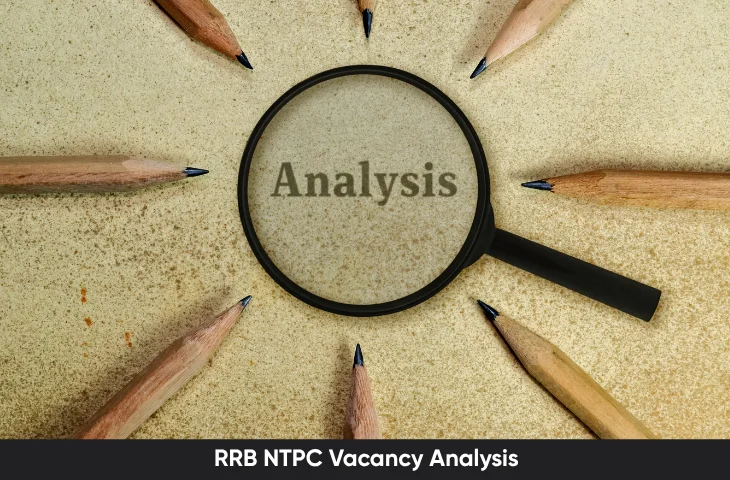Last updated on October 17th, 2025 at 10:11 am
The Railway Recruitment Board (RRB) NTPC (Non-Technical Popular Categories) exam has been one of the most anticipated recruitment drives in India. With millions of aspirants competing for government jobs every year, understanding the trends in RRB NTPC vacancies over the past decade (2010–2025) can help candidates strategize their preparation effectively.
This article provides a comprehensive RRB NTPC vacancy analysis, highlighting the growth, shrinkage, and key influencing factors over the last 15 years.
Overview of RRB NTPC Vacancy Trends (2010–2025)
Over the past decade, RRB NTPC vacancies have fluctuated due to multiple factors, including government policies, economic conditions, technological advancements, and external disruptions like the COVID-19 pandemic. The number of vacancies has not followed a linear trend; instead, it has seen periods of growth, stability, and decline.
1. 2010–2015: Gradual Growth and Stability
During this period, RRB NTPC vacancies were relatively stable, with slight increases each year:
- 2010–2011: Around 15,000–18,000 vacancies.
- 2012–2013: Vacancies increased gradually to approximately 22,000–27,000.
- 2014–2015: The total vacancies ranged between 25,000–30,000.
Key Insights:
- The government was gradually expanding recruitment to fill vacant positions in Indian Railways.
- Training and coaching centers started guiding candidates systematically during this period.
2. 2016–2019: Surge in Vacancies
This period witnessed a major surge in NTPC vacancies, making it a golden phase for aspirants:
- 2016: Around 35,000 vacancies announced.
- 2017–2018: A slight dip to 30,000 vacancies.
- 2019: Peak recruitment with over 35,000 vacancies across graduate and undergraduate posts.
Key Insights:
- Government initiatives aimed at employment generation boosted the number of NTPC vacancies.
- This period marked the largest NTPC recruitment drive in the last decade.
3. 2020–2025: Decline and Recovery Post-Pandemic
The pandemic and policy shifts influenced vacancy trends during this period:
- 2020–2021: Recruitment was paused due to COVID-19, leading to 0 vacancies announced.
- 2022: Vacancies resumed with approximately 15,000 positions.
- 2023–2024: Gradual decrease to around 10,000–11,558 vacancies.
- 2025: Latest data shows 8,850 vacancies, comprising 5,800 graduate-level posts and 3,050 undergraduate-level posts
Key Insights:
- The pandemic caused temporary disruption but also highlighted the importance of timely recruitment.
- Despite lower numbers, the vacancies remain significant for aspirants targeting government jobs.
Year-wise RRB NTPC Vacancy Analysis Table
The table below shows the RRB NTPC Vacancy Analysis for the candidates:
| Year | Estimated NTPC Vacancies | Trend | Remarks |
| 2010 | 15,000–20,000 | Stable | Initial recruitment phase, moderate vacancies |
| 2011 | 18,000–22,000 | Slight Increase | Growing demand for non-technical staff |
| 2012 | 20,000–25,000 | Stable | Consistent vacancies across zones |
| 2013 | 22,000–27,000 | Slight Increase | Focus on filling backlog positions |
| 2014 | 25,000–30,000 | Moderate Increase | More graduate-level posts added |
| 2015 | 20,000–25,000 | Slight Decline | Adjustments in recruitment policy |
| 2016 | 35,000 | Significant Surge | Government employment push |
| 2017 | 30,000 | Slight Decline | Stabilization after surge |
| 2018 | 30,000 | Stable | Similar pattern as previous year |
| 2019 | 35,000 | Peak | Largest recruitment drive of the decade |
| 2020 | 0 | Halt | COVID-19 pandemic disruption |
| 2021 | 0 | Halt | Recruitment paused globally |
| 2022 | 15,000 | Recovery | Resume of NTPC recruitment |
| 2023 | 10,000 | Decline | Gradual reduction in vacancies |
| 2024 | 11,558 | Stable | Minor increase due to deferred recruitment |
| 2025 | 8,850 | Lowest | Shrinking trend post-pandemic |
Factors Influencing Vacancy Trends
Several key factors have contributed to the rise and fall of NTPC vacancies over the last decade:
- Government Employment Policies: Increased recruitment during 2016–2019 to boost job creation.
- Economic Conditions: Economic slowdowns or budget constraints led to reduced vacancies.
- Technological Automation: Automation in Indian Railways reduced demand for certain non-technical roles.
- Pandemic Disruptions: COVID-19 halted recruitment in 2020–2021.
- Policy Shifts: New recruitment norms and revised educational eligibility influenced vacancy numbers.
Key Takeaways from RRB NTPC Vacancy Analysis
The major points of RRB NTPC Vacancy Analysis are discussed below. Candidates can have a quick look:
- Peak Years: 2016 and 2019 were the most favourable for aspirants with over 35,000 vacancies.
- Lowest Vacancies: 2025 marks the lowest point in the decade with 8,850 positions.
- Trends: Vacancy numbers are not linear; they reflect a mix of policy-driven increases and external disruptions.
- Preparation Implication: Aspirants should not rely solely on high vacancy years but should maintain consistent preparation to compete in any scenario.
The RRB NTPC vacancy analysis over the last decade highlights the dynamic nature of recruitment in Indian Railways. While there have been periods of significant growth, recent years indicate a shrinking trend, influenced by external factors like pandemics, policy changes, and technological advancements.
For aspirants, understanding these trends is crucial:
- Stay updated with official RRB notifications.
- Prepare consistently, regardless of vacancy trends.
- Strategize based on previous patterns to maximize chances of selection.
FAQs
RRB NTPC vacancy analysis is the study of trends in the number of Non-Technical Popular Categories (NTPC) vacancies announced by the Railway Recruitment Board over a period of time. It helps aspirants understand periods of growth, decline, and stability in recruitment.
Over the past decade, vacancies have seen periods of stability (2010–2015), a surge (2016–2019), and a decline (2020–2025). The peak was in 2019 with over 35,000 vacancies, while the lowest in recent years is 8,850 in 2025.
Key factors include government employment policies, economic conditions, technological automation, policy shifts, and external disruptions like the COVID-19 pandemic, which temporarily halted recruitment in 2020–2021.
Yes. When vacancies decrease, the competition intensifies because the number of applicants remains high. Aspirants must focus on consistent preparation, previous year papers, and time management strategies to secure selection.
Candidates can use vacancy trends to:
Identify peak recruitment periods and anticipate future drives.
Strategize preparation for highly competitive years.
Focus on consistently improving performance, as competition may be higher in shrinking-vacancy years.
- RRB NTPC Medical Test 2025, Check Post Wise Medical Criteria
- RRB NTPC Undergraduate Notification 2025, Apply for 3058 Posts
- RRB NTPC परीक्षा के लिए स्टेटिक जीके टॉपिक, यहां जानिए सभी टॉपिक्स
- RRB NTPC vs SSC CGL vs IBPS Clerk, Check Complete Analysis
- Importance of RRB NTPC Psycho Test, Know the Details of Test
- रेलवे परीक्षा की तैयारी करें, सारी जानकारी यहां देखें

Hello! This is Arijit Dutta. I am a skilled Content Writer at Oliveboard with nearly 3+ years of experience in crafting engaging, informative, and exam-focused content for the Railways Domain. With a strong command of language and a keen understanding of learner needs, I contribute significantly to Oliveboard’s mission of delivering high-quality educational resources. Passionate about clear communication and continuous learning, I consistently create content that helps government job aspirants achieve their goals. Outside of work, I enjoy playing cricket and listening to music, which helps me stay balanced and creative in my professional journey.
